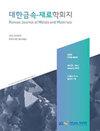用德拜-卡拉威模型分析Yb(Cd1-xMgx)2Sb2的晶格热导率
IF 1.1
4区 材料科学
Q4 MATERIALS SCIENCE, MULTIDISCIPLINARY
引用次数: 0
摘要
基于YbCd2Sb2的Zintl相由于其高的塞贝克系数和电导率而被确定为用于热电应用的有前途的材料。然而,它们的高导热性限制了它们的整体热电性能。为了解决这一问题,最近在Cd原子位点引入了Mg作为合金元素,以降低YbCd2Sb2的晶格热导率。张等人报道了Yb(Cd0.8Mg0.2)2Sb2在700K下的高zT(热电性能的优值)为1.4。他们已经证明,高zT是由于显著抑制了声子输运,换句话说,低晶格热导率。他们将晶格热导率极低归因于严重扭曲的晶格,即使使用Debye Callaway模型也无法描述。本文利用Debye Callaway模型和Callaway-von Baeyer模型,通过估算其理论晶格热导率,评估了Mg合金化对Yb(Cd1-xMgx)2Sb2(x=0,0.1,0.2)晶格热导率的影响。我们发现,适当拟合(Debye Callaway模型的)声子弛豫率中包含的参数,该参数表示体积模量与局部键长的分数变化,可以描述Yb(Cd1-xMgx)2Sb2(x=0,0.1,0.2)的晶格热导率被显著抑制。本文章由计算机程序翻译,如有差异,请以英文原文为准。
Lattice Thermal Conductivities of Yb(Cd1-xMgx)2Sb2 Analyzed via Debye-Callaway Model
YbCd2Sb2-based Zintl phases have been identified as promising materials for thermoelectric applications due to their high Seebeck coefficient and electrical conductivity. However, their high thermal conductivity limits their overall thermoelectric performance. To address this, Mg has recently been introduced as an alloying element at Cd atomic sites to reduce the lattice thermal conductivity of YbCd2Sb2 . Zhang et al. have reported a high zT (a figure-of-merit for the thermoelectric performance) of 1.4 at 700 K in Yb(Cd0.8Mg0.2)2Sb2. They have demonstrated that the high zT is due to significantly suppressed phonon transport, in other words, low lattice thermal conductivity. They attributed the significantly low lattice thermal conductivity to severely distorted lattices that could not be described even with the Debye-Callaway model. Here, the Debye-Callaway model and Callaway-von Baeyer model have been utilized to evaluate the effect of Mg alloying on the lattice thermal conductivity of Yb(Cd1-xMgx)2Sb2 (x = 0, 0.1, 0.2) by estimating their theoretical lattice thermal conductivities. We found that appropriately fitting the parameter included in the phonon relaxation rate (of the Debye-Callaway model), which represents a fractional change of bulk modulus to that of local bond length, could describe the significantly suppressed lattice thermal conductivities of Yb(Cd1-xMgx)2Sb2 (x = 0, 0.1, 0.2).
求助全文
通过发布文献求助,成功后即可免费获取论文全文。
去求助
来源期刊

Korean Journal of Metals and Materials
MATERIALS SCIENCE, MULTIDISCIPLINARY-METALLURGY & METALLURGICAL ENGINEERING
CiteScore
1.80
自引率
58.30%
发文量
100
审稿时长
4-8 weeks
期刊介绍:
The Korean Journal of Metals and Materials is a representative Korean-language journal of the Korean Institute of Metals and Materials (KIM); it publishes domestic and foreign academic papers related to metals and materials, in abroad range of fields from metals and materials to nano-materials, biomaterials, functional materials, energy materials, and new materials, and its official ISO designation is Korean J. Met. Mater.
 求助内容:
求助内容: 应助结果提醒方式:
应助结果提醒方式:


